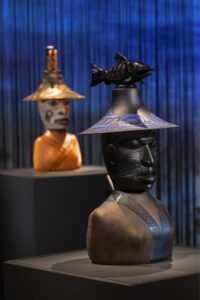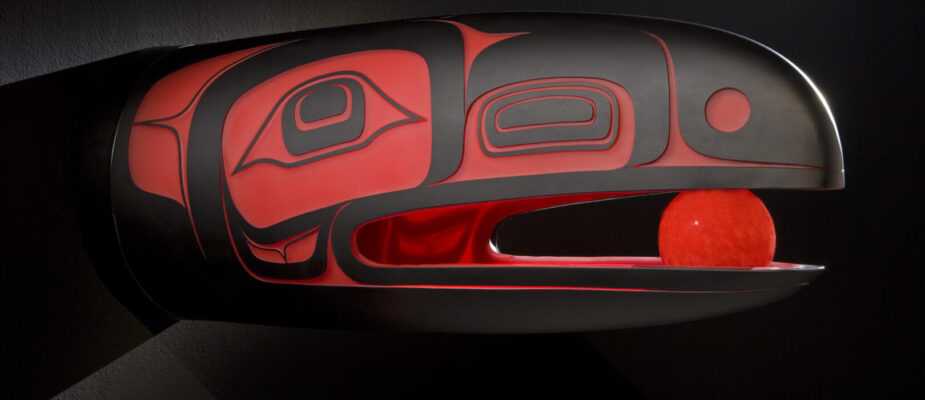By Kristen Pignuolo, Curatorial Assistant
Preston Singletary (b. 1963, Tlingit American), whose work is currently on view in the exhibition Preston Singletary: Raven and the Box of Daylight, is a glass artist known for fusing glassblowing traditions with traditional Tlingit (pronouced “kling-kit”) imagery. The Tlingit are Indigenous peoples of the Pacific Northwest Coast of North America, specifically the southeast coast of Alaska. While Tlingit designs are typically carved in wood or woven into baskets or cloth, Singletary has found that the medium of glass adds another dimension to Indigenous art.
To create a work of glass art, Singletary goes through a multi-step process that spans several days. First, the glass must be heated in a furnace to at least 2,000 degrees Fahrenheit to make it malleable. The molten glass is contained inside the furnace in a large container called a crucible. Then, a blowpipe (a metal pipe used to support the weight of the glass and also blow air into it) is inserted in the furnace and turned in the crucible until the molten glass attaches to it. Singletary blows and shapes the glass with the help of his assistants, moving back and forth from the steel workbench to the furnace to ensure the glass stays hot and malleable.
At this point, powdered colored glass is sifted onto the molten glass, melting into it and becoming fully incorporated. This process is repeated several times to build up multiple layers of color. Further shaping takes place until Singletary is satisfied with the result. Before moving forward in the process, the glass must be cooled slowly in an annealing oven for several days. If not cooled properly, inner stresses will develop and cause the glass to crack or even break.
Once the glass is fully cooled, Singletary works on the design that will be carved into the surface. Singletary often uses formline design, the primary artform used in Tlingit art, in his work. Formline utilizes lines that swell, contract, bend curve, and join to create a particular image or design.
To incorporate formline into glass, Singletary uses a unique process he calls “sandcarving” that he learned from fellow glass artist Kéké Cribbs while at the Pilchuck Glass School in Stanwood, WA. With this process, Singletary applies strips of rubber tape to his glass forms, on which he draws his design. He then cuts out the areas that he wants carved during the sandblasting process. The glass surface is carved away with fine grains of sand propelled by compressed air. The sand wears away at the different layers of glass, revealing the brilliant colors underneath. The effect of this sandcarving process is perhaps best displayed in Gagaan Awutáawu Yéil (Raven Steals the Sun), now on view in Preston Singletary: Raven and the Box of Daylight.

According to Singletary and his studio, busts like Xáat Sháa (Salmon Woman) are some of the most intricate and complex works in the exhibition, representing months or even years of work in the Hot Shop. This is because each individual piece (the figure’s body, head, hat, and any other additional decorations) must be individually designed and created. Once every piece is completed, they are then reheated to connect them and make a complete work of art.
Singletary’s unique aesthetic and use of innovative glassmaking techniques have resulted in art that simultaneously pushes the boundaries of glass and contemporary Indigenous art.
Check out videos of Singletary at work in the hot shop here: https://www.prestonsingletary.com/blog/post/sneak-peek-in-the-hot-shop
Image Credits
Preston Singletary (American Tlingit, born 1963). Gagaan Awutáawu Yéil (Raven Steals the Sun), Made at the Museum of Glass in 2008. Blown, hot-sculpted, and sand-carved glass; 9 1/2 x 26 x 9 1/2 in. Collection of Museum of Glass, Tacoma, gift of the artist. Photo by Russell Johnson.
Installation photograph of the exhibition Preston Singletary: Raven and the Box of Daylight, at the Museum of Glass Tacoma, October 3, 2018-September 2, 2019, photo by Russell Johnson.










